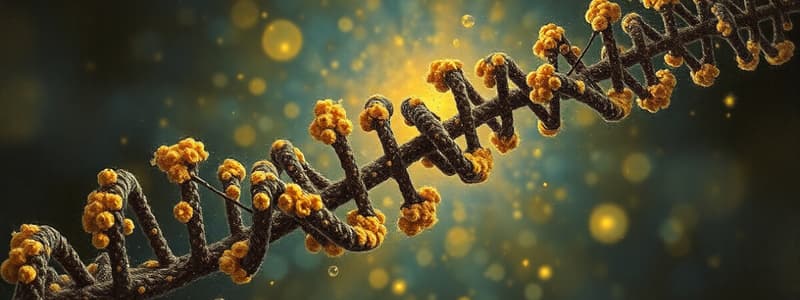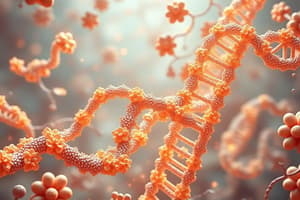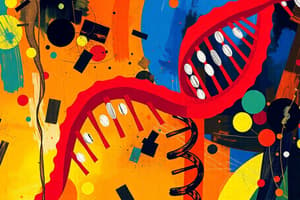Podcast
Questions and Answers
What is the primary role of ribosomes in the process of translation?
What is the primary role of ribosomes in the process of translation?
- To read the mRNA sequence and assemble proteins. (correct)
- To replicate DNA for cell division.
- To transport amino acids to the nucleus.
- To transcribe DNA into mRNA.
Which of the following is a characteristic of the small ribosomal subunit?
Which of the following is a characteristic of the small ribosomal subunit?
- It is not involved in reading the mRNA
- It is only needed after initial binding.
- It contains the peptidyl transferase center.
- It contains the decoding center for mRNA reading. (correct)
What is the role of tRNAs in the process of translation?
What is the role of tRNAs in the process of translation?
- They transcribe mRNA from a DNA template.
- They deliver amino acids to the ribosome. (correct)
- They catalyze the formation of peptide bonds.
- They initiate DNA replication.
During translation, what is the function of the A-site on the ribosome?
During translation, what is the function of the A-site on the ribosome?
What is the sequence of a tRNA molecule primarily responsible for?
What is the sequence of a tRNA molecule primarily responsible for?
The genetic code is read in three-nucleotide units called:
The genetic code is read in three-nucleotide units called:
What did the Nirenberg experiment primarily demonstrate about the genetic code?
What did the Nirenberg experiment primarily demonstrate about the genetic code?
What is translocation during the process of translation?
What is translocation during the process of translation?
What is the direct role of release factors (RF1, RF2, RF3) in the termination of translation?
What is the direct role of release factors (RF1, RF2, RF3) in the termination of translation?
In bacterial cells, how does the process of co-translational control in the tryptophan (trp) operon work?
In bacterial cells, how does the process of co-translational control in the tryptophan (trp) operon work?
What happens to the trp operon when tryptophan levels are low?
What happens to the trp operon when tryptophan levels are low?
What is the role of the attenuator in the tryptophan (trp) operon?
What is the role of the attenuator in the tryptophan (trp) operon?
Which antibiotic interferes with protein synthesis by binding to the 50S ribosomal subunit and inhibiting the formation of peptide bonds?
Which antibiotic interferes with protein synthesis by binding to the 50S ribosomal subunit and inhibiting the formation of peptide bonds?
How do aminoglycoside antibiotics interfere with protein translation?
How do aminoglycoside antibiotics interfere with protein translation?
What is a shared structural property of all tRNA molecules?
What is a shared structural property of all tRNA molecules?
Why every amino acid is encoded by more than one codon?
Why every amino acid is encoded by more than one codon?
Which of the following statements accurately describes the arrangement of A, P, and E sites of a ribosome
Which of the following statements accurately describes the arrangement of A, P, and E sites of a ribosome
How does the initiation tRNA differ from subsequent tRNAs entering the ribosome during translation?
How does the initiation tRNA differ from subsequent tRNAs entering the ribosome during translation?
During attenuation of the trp operon, what event is stimulated when tryptophan is high?
During attenuation of the trp operon, what event is stimulated when tryptophan is high?
What is peptidyl transferase responsible for during translation?
What is peptidyl transferase responsible for during translation?
Following translation, what happens to tRNAs?
Following translation, what happens to tRNAs?
Which best explains the reason for the primary structure of a tRNA molecule usually contains modified bases?
Which best explains the reason for the primary structure of a tRNA molecule usually contains modified bases?
Which is a property common to all proteins?
Which is a property common to all proteins?
What is the function of EFG?
What is the function of EFG?
Where does translation occur?
Where does translation occur?
What is the difference between prokaryotic and eukaryotic translation?
What is the difference between prokaryotic and eukaryotic translation?
How is a protein's higher order structure determined?
How is a protein's higher order structure determined?
During what process does aminoacyl-tRNA synthetase play a role?
During what process does aminoacyl-tRNA synthetase play a role?
What happens if a mutation changes the sequence of nucleotides of a codon?
What happens if a mutation changes the sequence of nucleotides of a codon?
Flashcards
Translation
Translation
The process where ribosomes read transcribed mRNA to generate a protein.
Primary structure
Primary structure
The sequence of amino acids in a polypeptide chain.
Secondary structure
Secondary structure
Local folded structures within a polypeptide formed by interactions between backbone atoms.
Tertiary structure
Tertiary structure
Signup and view all the flashcards
Quaternary structure
Quaternary structure
Signup and view all the flashcards
Small ribosomal subunit
Small ribosomal subunit
Signup and view all the flashcards
Large ribosomal subunit
Large ribosomal subunit
Signup and view all the flashcards
A-site
A-site
Signup and view all the flashcards
P-site
P-site
Signup and view all the flashcards
E-site
E-site
Signup and view all the flashcards
Transfer RNAs (tRNAs)
Transfer RNAs (tRNAs)
Signup and view all the flashcards
Codons
Codons
Signup and view all the flashcards
translocation
translocation
Signup and view all the flashcards
Termination (translation)
Termination (translation)
Signup and view all the flashcards
trp operon
trp operon
Signup and view all the flashcards
trp repressor
trp repressor
Signup and view all the flashcards
Attenuation
Attenuation
Signup and view all the flashcards
mRNA Translation
mRNA Translation
Signup and view all the flashcards
Study Notes
- The lecture focuses on encoding proteins, or translation.
Recommended Biochemistry Textbook
- Biochemistry by T.A. Brown can be used as a resource.
Central Dogma of Molecular Biology
- DNA undergoes replication to produce more DNA.
- DNA undergoes transcription to produce RNA.
- RNA undergoes translation to produce protein, which leads to cellular function.
- Transcription is the enzymatic synthesis of RNA from a DNA template and forms the first step in gene expression
- Translation is the enzymatic synthesis of protein from an transcribed gene sequence into a functional RNA molecule mRNA
Protein Structure
- Primary structure is the amino acid sequence in a polypeptide chain.
- Secondary structure refers to local folded structures formed by interactions between backbone atoms.
- Tertiary structure is the overall 3D structure of a polypeptide, resulting from interactions between R groups of amino acids.
- Quaternary structure arises when multiple polypeptide chains (subunits) combine.
Amino Acids
- Amino acids are the building blocks of proteins and form peptide bonds.
Translation
- Translation is the process where ribosomes read the transcribed mRNA to generate a protein.
- In prokaryotes, translation is co-transcriptional.
- In eukaryotes, translation occurs after transcription, though some elements may be co-transcriptional.
- Translation occurs in the cytoplasm.
The Ribosome
- Responsible for reading the mRNA sequence and assembling the protein based on that message.
- It has a diameter of approximately 10 nm.
- Ribosomes consist of about 65% ribosomal RNA (rRNA) and 35% ribosomal proteins.
- Ribosome units are characterized by their sedimentation rate in Svedberg units (S).
- Under optimal conditions, rRNA and protein mixtures self-assemble into a ribosome.
- Ribosomes' RNAs have both structural and catalytic activity.
- The small ribosomal subunit contains the decoding center required for reading mRNA.
- The large ribosomal subunit contains the peptidyl transferase center, which has catalytic RNA.
- Multiple ribosomes loaded onto a single mRNA strand are called a polyribosome.
- Transfer RNAs (tRNAs) occupy the A, P, and E sites and carry amino acids.
- The A-site is the acceptor site where amino-acyl tRNA lands.
- The P-site is occupied by peptidyl-tRNA, where the last amino acid was added.
- The E-site is the exit site where tRNA leaves the ribosome after transferring its amino acid.
- The A, P, and E sites lie in the large subunit but are completed when the small unit is present.
Transfer RNAs (tRNAs)
- Adapter molecules that deliver amino acids to the ribosome.
- The primary structure of a tRNA is between 60 and 95 nt long (most commonly 75 nt) that contains many (>20%) post-transcriptionally modified bases
- All tRNAs have the same basic secondary 'clover-leaf' structure
- There are significant levels of intra-tRNA hydrogen bonding sites
Reading the Genetic Code
- mRNA sequence carries its message in 3-letter "words".
- The genetic code is essentially a continuous run of 3 nucleotide triplets known as codons.
- Translation is the process whereby the codons are read and the information used to insert an amino-acid into the growing polypeptide
- Virtually every amino-acid is encoded by more than one codon - a redundancy is built-in to the code
Deciphering the Genetic Code: Nirenberg Experiment
- Marshall Nirenberg and his team synthesized mRNA with repeating nucleotides for their experiments.
- They added these synthetic mRNAs to E. coli cell lysate.
- The resulting proteins were isolated to see what amino acids were incorporated.
- 5′-UUUUUUUU-3′-OH gave poly-Phenylalanine.
- 5′-AAAAAAAA-3′-OH gave poly-Lysine
- 5′-CCCCCCCC-3′-OH gave poly-Proline
- Repeating 5′-AUAUAU.....3′-OH resulted in a protein containing alternating isoleucine and tyrosine.
Translation in Prokaryotes
- Components needed for translation include mRNA, tRNA, ribosomes, GTP, initiation factors, and elongation factors.
- Translation occurs in 3 stages: initiation, elongation, and termination.
- Movement of the ribosome along the mRNA is called translocation.
- Purpose of the initiation step is to assemble the translation “machinery" at the translation start site
- Initiator tRNA enters the P-site, while all subsequent tRNAs enter the A-site.
- In addition, 3 initiation factors and a molecule of GTP are required
- The elongation step involves aminoacyl-tRNA delivery, peptide bond formation, and translocation.
- After initiation, the P-site is occupied, and the A-site is empty.
- Three elongation factors are recruited, all can bind GDP or GTP.
- The ribosome complex maintains a 6 bp contact with the mRNA, which stops frame-shifting.
- Elongation continues until a termination codon is read in the A-site.
- Termination occurs when there are no tRNAs that recognize a STOP codon
- Protein release factors interact with these codons and bring about the release of the polypeptide chain
- Release Factor 1 (RF1) recognises UAA and UAG
- RF 2 recognises UAA and UGA
- RF3 helps RF1 and RF2 to carryout their role
- Release factor causes the peptidyl transferase to transfer the polypeptide to water rather than to the next tRNA – so the protein is then released
- EF-G and a RF are required for the disciation of the ribosome complex from the mRNA, and removal of the uncharged tRNA from the P-site
Co-translational Control: The Tryptophan Operon
- Transcription and translation occur simultaneously in bacterial cells.
- As mRNA is generated, it is also being read by a ribosome (protein production)
- It uses this co-translation as a control point for gene expression regulation.
- The trp operon, found in E. coli, is a group of genes that encode biosynthetic enzymes for tryptophan, a rare amino acid.
- The trp operon is expressed (turned "on") when tryptophan levels are low and repressed (turned "off") when they are high.
- It is regulated by the trp repressor, which blocks expression when bound to tryptophan.
- Biosynthesis is also regulated by attenuation, a process based on coupling transcription and translation.
- Attenuation functions as a control mechanism when tryptophan levels are high, stopping ribosome progression along the mRNA.
- Control sequence is used to respond to tryptophan levels
- It lies between the operator and the first gene if the operon and is called the leader sequence
- The leader sequence encodes a short polypeptide and also contains an attenuator sequence.
Interfering with Protein Translation
- Chloramphenicol binds to 50S & inhibits formation of peptide bond
- Macrolides, Clindamycin & Streptogramins block the polypeptide exit tunnel on 50S & prevent peptide chain elongation
- Linezolid binds to 50S & prevents formation of the 50/30S ribosomal complex
- Aminoglycosides bind to 30S & causes mRNA codon to be misread; interfere with the initiation complex of 30S & 50S with mRNA
- Tetracyclines bind to 30S & interfere with binding of tRNA to ribosomal complex
Protein Physicochemical Properties
- Contains carbon, hydrogen, oxygen, nitrogen
- Will have a defined structure/shape
- Will have a defined mass
- Will absorb light in the UV range
- Will contain both charged and uncharged amino acids
- Will contain hydrophilic and hydrophobic amino acids
Summary
- How the mRNA sequence is turned into protein
- How the genetic code was elucidated experimentally
- How transcription and translation can be combined for gene expression control
- How we can interfere with the translation process
Studying That Suits You
Use AI to generate personalized quizzes and flashcards to suit your learning preferences.



